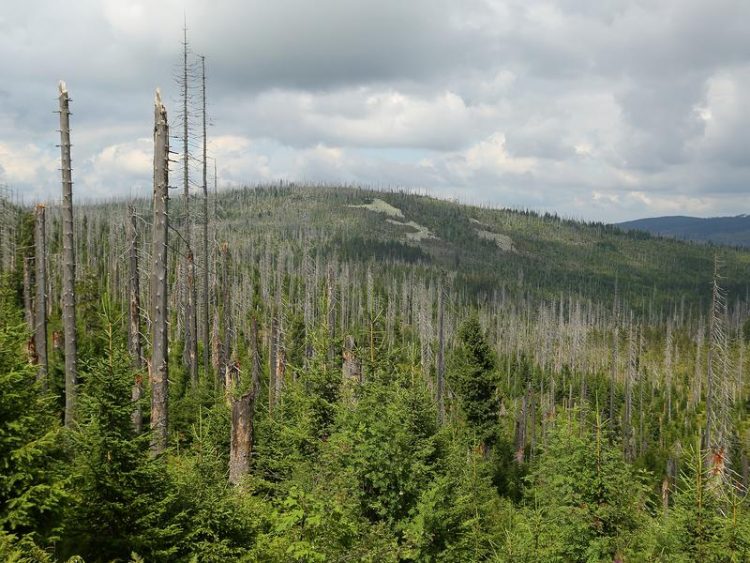Preventing Future Forest Diebacks

Spruces killed by bark beetles on the Lusen in the Bavarian Forest National Park in Germany. Ecologists call for preserving most of that dead wood in forests. Simon Thorn / University of Wuerzburg
Bark beetles, heat, drought, storms, and fires have damaged the German forests. Those who go for a walk there often encounter dead spruces and dried beech trees. “The forests are affected in all regions and need quick help,” says the website of the German Federal Ministry of Food and Agriculture.
Clear and reforest: this is how the ministry imagines this help. Minister Julia Klöckner plans a large-scale clear-up followed by reforestation programme. At least 500 million euros are needed for the programme and subsequent maintenance.
Researchers call for a radical change
Clear-up and reforestation is not the right strategy, forest ecologists Simon Thorn, Joerg Mueller and Alexandro Leverkus from Julius-Maximilians-Universität (JMU) Würzburg in Bavaria, Germany, write in Science magazine.
“This policy is likely to create extensive, even forest stands that remain particularly vulnerable to the impacts of future climate change,” says Simon Thorn.
Germany should therefore reconsider its strategic and financial efforts to create forests resilient to future climate change. Here a radical change is necessary: The scientists suggest not to remove dead wood and not to conduct reforestation on large scales.
Preserving dead wood
For centuries, forestry has followed a clearing and reforestation strategy. The consequences: a steady decline in biological diversity and the extinction of many fungi and insects that depend on dead wood.
According to Thorn, large-scale clear-ups following natural disturbances have negative effects on the diversity of insects which are dependent on deadwood.
This collides with the goals of the government’s coalition agreement, according to which the dramatic decline of insects should be halted. Instead, public subsidies should be aimed at preserving dead wood created by disturbances.
Safeguarding open forests
Natural disturbances such as storms, bark beetle outbreaks and drought create canopy gaps, which enable the regrowth of a wide variety of native tree species. According to the scientists, this increases the resistance of a forest to extreme weather events.
In contrast, rapid reforestation leads to dense groups of trees of the same age, which are highly susceptible to weather events and pests. Subsidies for forestry should better promote a diverse tree and age structure as well as the presence of canopy gaps. This strategy would simultaneously benefit economically important tree species and preserve endangered insects.
Forest Dieback 2.0:
In the 1980s there was extensive forest damage in Central Europe, mainly caused by air pollution due to industry and traffic. At that time there was talk of “Waldsterben” or “Forest Dieback”. The current catchword “Waldsterben 2.0” refers to this period. The addition “2.0” expresses that the current forest damage has other causes this time – namely climate change.
Dr. Simon Thorn, Ecological Station, University of Würzburg, T +49 931 31-83057, simon.thorn@uni-wuerzburg.de
Preventing European forest diebacks. Simon Thorn, Jörg Müller, Alexandro B. Leverkus. Science, September 27, 2019. DOI: 10,1126/science.aaz3476
https://www.biozentrum.uni-wuerzburg.de/en/station/start-page/ Ecological Field Station of the University of Würzburg
https://www.bmel.de/DE/Wald-Fischerei/Forst-Holzwirtschaft/_texte/Wald-Trockenhe… Federal Ministry of Agriculture: Sustainable forestry / in german language
https://www.bundesregierung.de/breg-de/aktuelles/insektensterben-stoppen-1138930 Federal Government: Stop insect mortality / in german language
Media Contact
All latest news from the category: Ecology, The Environment and Conservation
This complex theme deals primarily with interactions between organisms and the environmental factors that impact them, but to a greater extent between individual inanimate environmental factors.
innovations-report offers informative reports and articles on topics such as climate protection, landscape conservation, ecological systems, wildlife and nature parks and ecosystem efficiency and balance.
Newest articles

A ‘language’ for ML models to predict nanopore properties
A large number of 2D materials like graphene can have nanopores – small holes formed by missing atoms through which foreign substances can pass. The properties of these nanopores dictate many…

Clinically validated, wearable ultrasound patch
… for continuous blood pressure monitoring. A team of researchers at the University of California San Diego has developed a new and improved wearable ultrasound patch for continuous and noninvasive…

A new puzzle piece for string theory research
Dr. Ksenia Fedosova from the Cluster of Excellence Mathematics Münster, along with an international research team, has proven a conjecture in string theory that physicists had proposed regarding certain equations….



